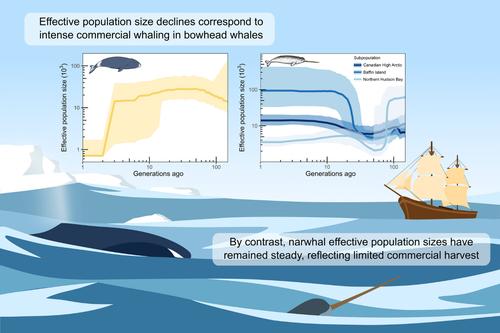当前位置:
X-MOL 学术
›
Glob. Change Biol.
›
论文详情
Our official English website, www.x-mol.net, welcomes your
feedback! (Note: you will need to create a separate account there.)
Unraveling the Genetic Legacy of Commercial Whaling and Population Dynamics in Arctic Bowhead Whales and Narwhals
Global Change Biology ( IF 10.8 ) Pub Date : 2024-10-14 , DOI: 10.1111/gcb.17528 Evelien de Greef, Claudio Müller, Matt J. Thorstensen, Steven H. Ferguson, Cortney A. Watt, Marianne Marcoux, Stephen D. Petersen, Colin J. Garroway
Global Change Biology ( IF 10.8 ) Pub Date : 2024-10-14 , DOI: 10.1111/gcb.17528 Evelien de Greef, Claudio Müller, Matt J. Thorstensen, Steven H. Ferguson, Cortney A. Watt, Marianne Marcoux, Stephen D. Petersen, Colin J. Garroway

|
Assessing genetic structure and diversity in wildlife is particularly important in the context of climate change. The Arctic is rapidly warming, and endemic species must adapt quickly or face significant threats to persistence. Bowhead whales (Balaena mysticetus ) and narwhals (Monodon monoceros ) are two long‐lived Arctic species with similar habitat requirements and are often seen together in the Canadian Arctic. Although their ranges overlap extensively, bowhead whales experienced significantly greater commercial whaling mortality than narwhals over several centuries. The similar habitat requirements but different harvest histories of these two species provide an opportunity to examine present‐day genetic diversity and the demographic and genetic consequences of commercial whaling. We whole‐genome resequenced contemporary Canadian Arctic bowhead whales and narwhals to delineate population structure and reconstruct demographic history. We found higher genetic diversity in bowhead whales compared to narwhals. However, bowhead whale effective population size sharply declined contemporaneously with the intense commercial whaling period. Narwhals, in contrast, exhibited recent growth in effective population size, likely reflecting exposure to limited opportunistic commercial harvest. Bowhead whales will likely continue to experience significant genetic drift in the future, leading to the erosion of genetic diversity. In contrast, narwhals do not seem to be at imminent risk of losing their current levels of genetic variation due to their long‐term low effective population size and lack of evidence for a recent decline. This work highlights the importance of considering population trajectories in addition to genetic diversity when assessing the genetics of populations for conservation and management purposes.
中文翻译:

揭示商业捕鲸的遗传遗产和北极弓头鲸和独角鲸的种群动态
在气候变化的背景下,评估野生动物的遗传结构和多样性尤为重要。北极正在迅速变暖,特有物种必须迅速适应,否则将面临持续存在的重大威胁。弓头鲸 (Balaena mysticetus) 和独角鲸 (Monodon monoceros) 是两种长寿的北极物种,具有相似的栖息地要求,经常在加拿大北极地区一起出现。尽管它们的活动范围广泛重叠,但在几个世纪以来,弓头鲸的商业捕鲸死亡率明显高于独角鲸。这两个物种的栖息地要求相似,但捕鲸历史不同,这为研究当今的遗传多样性以及商业捕鲸的人口和遗传后果提供了机会。我们对当代加拿大北极弓头鲸和独角鲸进行了全基因组重新测序,以描绘种群结构并重建人口历史。我们发现,与独角鲸相比,弓头鲸的遗传多样性更高。然而,弓头鲸的有效种群规模与密集的商业捕鲸期同时急剧下降。相比之下,独角鲸的有效种群规模最近有所增长,这可能反映了对有限机会性商业捕捞的暴露。弓头鲸未来可能会继续经历严重的遗传漂变,从而导致遗传多样性的侵蚀。相比之下,独角鲸似乎并没有面临失去当前遗传变异水平的迫在眉睫的风险,因为它们的长期有效种群规模较低并且缺乏最近下降的证据。 这项工作强调了在出于保护和管理目的评估种群遗传学时,除了遗传多样性之外,考虑种群轨迹的重要性。
更新日期:2024-10-14
中文翻译:

揭示商业捕鲸的遗传遗产和北极弓头鲸和独角鲸的种群动态
在气候变化的背景下,评估野生动物的遗传结构和多样性尤为重要。北极正在迅速变暖,特有物种必须迅速适应,否则将面临持续存在的重大威胁。弓头鲸 (Balaena mysticetus) 和独角鲸 (Monodon monoceros) 是两种长寿的北极物种,具有相似的栖息地要求,经常在加拿大北极地区一起出现。尽管它们的活动范围广泛重叠,但在几个世纪以来,弓头鲸的商业捕鲸死亡率明显高于独角鲸。这两个物种的栖息地要求相似,但捕鲸历史不同,这为研究当今的遗传多样性以及商业捕鲸的人口和遗传后果提供了机会。我们对当代加拿大北极弓头鲸和独角鲸进行了全基因组重新测序,以描绘种群结构并重建人口历史。我们发现,与独角鲸相比,弓头鲸的遗传多样性更高。然而,弓头鲸的有效种群规模与密集的商业捕鲸期同时急剧下降。相比之下,独角鲸的有效种群规模最近有所增长,这可能反映了对有限机会性商业捕捞的暴露。弓头鲸未来可能会继续经历严重的遗传漂变,从而导致遗传多样性的侵蚀。相比之下,独角鲸似乎并没有面临失去当前遗传变异水平的迫在眉睫的风险,因为它们的长期有效种群规模较低并且缺乏最近下降的证据。 这项工作强调了在出于保护和管理目的评估种群遗传学时,除了遗传多样性之外,考虑种群轨迹的重要性。


















































 京公网安备 11010802027423号
京公网安备 11010802027423号